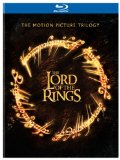| Reviews & Columns |
|
Reviews DVD TV on DVD Blu-ray 4K UHD International DVDs In Theaters Reviews by Studio Video Games Features Collector Series DVDs Easter Egg Database Interviews DVD Talk Radio Feature Articles Columns Anime Talk DVD Savant Horror DVDs The M.O.D. Squad Art House HD Talk Silent DVD
|
DVD Talk Forum |
|
|
| Resources |
|
DVD Price Search Customer Service #'s RCE Info Links |
|
Columns
|
|
|
Lord of the Rings Trilogy: Theatrical Editions, The
New Line // PG-13 // April 6, 2010
List Price: $99.98 [Buy now and save at Amazon]
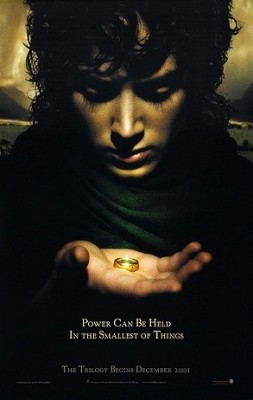 |
Moreover, what Peter Jackson created with his series was an appointment-worthy franchise that arrived every holiday season for three years straight, from '01 to '03. It became a tradition with our little clan to have a calorie-rich meal at a nice restaurant before venturing into the world of Middle-earth, building into a night of clanking swords, magical effects, and a sweeping story that continued almost seamlessly throughout the series' dominant theatrical run -- where it garnered over one billion dollars domestically. The anticipation seemed to happen almost instantaneously, though; promotional artwork and trailers spilled into the mainstream quickly, and it throttled the excitement for the first picture like the spark of a flame for fans of the fantasy picture. More importantly, Peter Jackson never falters in delivering exactly what was expected: thrilling, dazzling fun.
That's the experience New Line Home Video is replicating here with this Blu-ray boxset of the Lord of the Rings Trilogy, presenting the cuts that showed in theaters during their box office heyday in high-definition picture and sound. However, since then, film enthusiasts have had the opportunity to see the "extended versions" of Peter Jackson's three films (Fellowship of the Ring, Two Towers, and Return of the King), ones that are edited differently, contain new soundtrack elements, and beef up the story with, on average, around 35+ minutes of material. This time around, we're given the chance to relive the films in their theatrical glory, which -- though a bit less desirable than the extended versions, almost assuredly to come in the near future -- are still a delight to absorb once again.
An Overview of The Trilogy:
The Lord of the Rings focuses on Frodo (Elijah Wood), a hobbit from an idyllic little slice of paradise called The Shire, who must trek across the treacherous grounds of Middle-earth to destroy an all-powerful ring -- one that's linked to the life force of Sauron, an evil force on the rise to cover the world in darkness. He's accompanied by eight companions at first -- three other hobbits, an elf named Legolas (Orlando Bloom), the drawf Gimli (Jonathan Rhys-Davies), a warrior human named Boromir (Sean Bean), dormant kind Aragorn (Viggo Mortensen) and the powerful wizard Gandalf (Sir Ian McKellen) -- who lead him a sizable chunk of the way, but happenstance calls for Frodo to continue the trek in vastly smaller numbers as the narrative progresses. Jackson's adaptation of the material attempts to cover a dense array of books' subplots, including the fate of Aragorn as the true ruler of the lands of Middle-earth, the relationship between men and elves, the existence of one of the ring's previous owners, Sméagol (Andy Serkis), and the fate of Theoden's leadership as the king of Rohan. All that on top of saving the world.
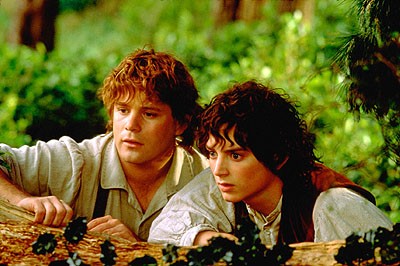 In The Fellowship of the Ring, Peter Jackson digs his heels into the broad mythology with grace. After a chill-inducing introduction to the events that occur before Frodo obtains the ring, including doom-swelling imagery of Sauron's mace-wielding destruction on the battlefield, he gives us a glimpse of the hobbits' home The Shire at a time of peace -- and how the ring at the root can cause distress even in this peaceful place. The film illustrates how men, elves, and hobbits alike surrender to its powerful draw, and why it's an instrument of equalization and earnest desperation that could cause the world to crumble based on the need for destructive, almost ubiquitous dominance over the lands. A necessary point in connecting with an audience comes in our ability to see the importance of the ring, not just as a link to the one-dimensionally evil Sauron but also as an alluring force that appeals to the hubris of dominance, and Jackson pins that down with the forces of good, neutral, and evil alike transfixed to its billowing lure.
In The Fellowship of the Ring, Peter Jackson digs his heels into the broad mythology with grace. After a chill-inducing introduction to the events that occur before Frodo obtains the ring, including doom-swelling imagery of Sauron's mace-wielding destruction on the battlefield, he gives us a glimpse of the hobbits' home The Shire at a time of peace -- and how the ring at the root can cause distress even in this peaceful place. The film illustrates how men, elves, and hobbits alike surrender to its powerful draw, and why it's an instrument of equalization and earnest desperation that could cause the world to crumble based on the need for destructive, almost ubiquitous dominance over the lands. A necessary point in connecting with an audience comes in our ability to see the importance of the ring, not just as a link to the one-dimensionally evil Sauron but also as an alluring force that appeals to the hubris of dominance, and Jackson pins that down with the forces of good, neutral, and evil alike transfixed to its billowing lure. Drenched in forest greens through Andrew Lesnie's heavily manipulated cinematography and carried by the production from Jackson's WETA Workshop / Weta Digital design houses, there's a sense of discovery about Middle-earth in The Fellowship of the Ring that's magical. It takes us through scenes in The Shire, along the road to the elvish land Rivendel, and through the dark mines of Moria in a fresh manner, witnessing the locations whittled out by J. R. R. Tolkien coming to life in a way that could only be done with this mix of digital and tangible effects. Sure, Peter Jackson could've made use of found locations in New Zealand on their own, along with the costume and make-up work, but his background with lurid madness in Dead Alive and animated fancy within his childhood drama Heavenly Creatures leads the Kiwi director to attempt an engulfing and creative vision -- and, boy, does he get it right.
What differs The Fellowship of the Ring from the other films in the series is its focus on character history and mythos instead of popcorn-munching, full-throttle excitement, built in a introductory way appealing to grand storytelling and a superb mix of theatrics and action. We're getting to know these characters before they're rooted in their archetypes, something that's a necessary evil as the storyline progresses; affection is built for them as the storyline throttles forward with swords clanking and magic soaring, but it's only after we've sorted out their "alignment" for ourselves -- Gimli's reluctant determination, Boromir's easily-swayed need for power, and Aragorn's unyielding allegiance. The presence of Sauron and his white wizard henchman, Saruman (Christopher Lee), lean on mysteriousness to us at this point, and the novelty of their darkness pairs well with the discovery of the ways our lead characters' act and react. It's, well, like reading the first chapters of a great book, with entities interwoven in a bleak yet hopeful environment. Because of its skill in kick-starting both the visual and textual construction of this mythic world, and igniting our fascination with it, it's easy to acknowledge this installment as the most finely-crafted of the trilogy.
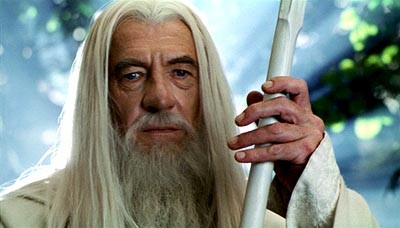 Jackson must've known that The Fellowship of the Ring would construct a bleak foundation underneath the feet of the characters, because The Two Towers quickly leads into more robust pacing and consistent, enthralling action sequences to liven the mood, for better or worse. It finds the Fellowship separated and the mystery behind the ring's history being partly revealed through our interaction with its past holders, but it also allows its characters to find a comfort zone in their demeanor. Frodo spirals further into the bleak control of the ring as Samwise aides his journey, Aragorn takes the reigns as a chivalric warrior inching his way towards becoming a king, and the rest of the fellowship leans on the mannerisms that suit them best as Gandolf experiences a shift in consciousness. Legolas remains stoic yet warming, Gimli becomes more of a comic relief, and the twosome of Merry (Dominic Monaghan) and Pippin (Billy Boyd), mostly separated from the rest of the characters in this installment, show their worth while remaining foolishly oafish. Development of character isn't paramount in this middle-ground entry in the story, at least not for the primary characters.
Jackson must've known that The Fellowship of the Ring would construct a bleak foundation underneath the feet of the characters, because The Two Towers quickly leads into more robust pacing and consistent, enthralling action sequences to liven the mood, for better or worse. It finds the Fellowship separated and the mystery behind the ring's history being partly revealed through our interaction with its past holders, but it also allows its characters to find a comfort zone in their demeanor. Frodo spirals further into the bleak control of the ring as Samwise aides his journey, Aragorn takes the reigns as a chivalric warrior inching his way towards becoming a king, and the rest of the fellowship leans on the mannerisms that suit them best as Gandolf experiences a shift in consciousness. Legolas remains stoic yet warming, Gimli becomes more of a comic relief, and the twosome of Merry (Dominic Monaghan) and Pippin (Billy Boyd), mostly separated from the rest of the characters in this installment, show their worth while remaining foolishly oafish. Development of character isn't paramount in this middle-ground entry in the story, at least not for the primary characters. Two new plot points, the faded rule of Rohan and the presence of previous ringbearer Sméagol, take a central, clean spotlight in The Two Towers as the network of secondary plots convolute outside of Frodo's journey towards Mount Doom -- the central drive behind the films that's, ultimately, unconnected to much of the other happenings. King Theoden (Bernard Hill), a once-powerful ruler, has been bewitched by one of Saruman's minions to a point of near-death inertia, plaguing his rule so much that he's blinded even to the allegiance of his family. The township's importance to the story mostly roots in the state of humankind underneath Sauron's thumb, and what it'll be like if he tightens his grasp. On top of that, we're given an intimate conflict between Frodo, Samwise, and the slithering presence of Sméagol -- brought to life with still-impressive clout by a combo of Andy Serkis' vocal / bodily performance and the massively impressive digital make-up of his gaunt body -- as the ring's power to contort those around it becomes more and more evident within their murky, cerebral twists on mental turmoil and allegiances.
Bilbo Baggins uses a metaphor in The Fellowship of the Ring that properly describes The Two Towers: he refers to the way he feels as a piece of bread with butter spread too thin on top. This second installment into the Lord of the Rings trilogy feels as if the thematic materials from the first and third films are simply stretched over into the contents of this second picture, while raucous battles and dazzling special effects increase in frequency as if to fill in the gaps. Computer-generated grandeur, including renderings of wild dog-like beasts and legions upon legions of Orcs, is used more as a device for spectacle instead of seamless storytelling; it satisfies our eyes, yet its persistence wears thin as the unfurling story wains. Some of it even borders on the absurd and unbelievable, such as a scene involving a charge of horses late in the picture; however, the competent construction and steadfast fervor behind Jackson's vision persevere and still craft this into an ample and deserving motion picture. It's more about a collection of moments that thrillingly drag us to the third installment by our bootstraps.
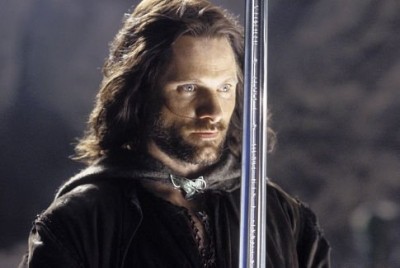 A lot of momentum leads into The Return of the King, the mammoth conclusion to the Lord of the Rings saga, where we've developed a sense of hope for the fate of Middle-earth as Frodo and his companions see the billowing lava of Mount Doom growing closer and closer. The sensation concocted by Jackson to this point is somewhat compelling and different, as the threat of Mordor and Sauron's minions offer more of a benchmark villain to be conquered than a force to be feared. Our morale ebbs and flows with the rest of Middle-earth's disparate yet unfaltering denizens, which center on the fate of mankind in several different locations -- Gondor, Rohan, and the massive flagpole keep of Minas Tirith -- as a war brews between good and evil. What questions we have left are primary to the storyline: how will Frodo scale Mount Doom and destroy the ring, will the visions seen of Minas Tirith engulfed in defeatist flames come true, and will Aragorn finally take his rightful place as king and lead his people to salvation?
A lot of momentum leads into The Return of the King, the mammoth conclusion to the Lord of the Rings saga, where we've developed a sense of hope for the fate of Middle-earth as Frodo and his companions see the billowing lava of Mount Doom growing closer and closer. The sensation concocted by Jackson to this point is somewhat compelling and different, as the threat of Mordor and Sauron's minions offer more of a benchmark villain to be conquered than a force to be feared. Our morale ebbs and flows with the rest of Middle-earth's disparate yet unfaltering denizens, which center on the fate of mankind in several different locations -- Gondor, Rohan, and the massive flagpole keep of Minas Tirith -- as a war brews between good and evil. What questions we have left are primary to the storyline: how will Frodo scale Mount Doom and destroy the ring, will the visions seen of Minas Tirith engulfed in defeatist flames come true, and will Aragorn finally take his rightful place as king and lead his people to salvation? We receive answers to these questions in grand fashion, as Jackson leads us into the conclusion to this story arc with confident, balls-out abandon and gut-wrenching visuals. Emotions intensify between Frodo and Sméagol as their interpersonal war for the ring grows thicker, offering a clever mental struggle that never falters to capture our attention amid its manipulation. As they scale rocks and sludge through the dark recesses near the mountain, including within a deadly spider's lair, their exhaustion offers a reminder that their road's not an easy one. Aragorn, Legolas,and the rest might be shooting arrows and lopping the heads off of Orcs amid the strikingly crafted contours of Minas Tirith, but the central battle for mental control over the ring becomes the paramount -- and potent -- driving force behind the suspense generated in The Return of the King. That's not to lower the value of the grand battles, which grow even broader in scope than those in The Two Towers; oddly, as the creatures grow more whimsical and massive here, the concentration on the battles' intensity achieves a tighter draw power. Giant "evil" elephants destroy legions of Middle-earth's good-willed fighters, giant winged lizards swoop above our heads, and massive boulders plaster holes into the walls of an otherwise-indestructible keep, but the liveliness behind it all makes it so that we're able to evocatively grab hold of this grandiose construction -- even relish in its sturdy ability to be so darned massive in scale.
The Return of the King earned 11 Academy Awards, including Best Picture, but they're more acknowledgements for the entire series than they are for this film's singular accomplishments. That's not to say that The Return of the King isn't a worthwhile deserver of the crown, because the breath-snatching momentum leading up to the last chivalric moments give a pointed and exciting conclusion to an exhaustive series of films -- nearly ten hours, from the first moments in The Shire to the final hurrah in Mordor. It takes a lot of skill to hold attention for that long a period, intermixing grand sword-crunching, arrow-flying battles with grotesquery, adult themes, a scattering of easy-to-digest cerebral complexity and an overall sense of victorious suspense for the people of Middle-earth, something that Jackson and his WETA crew and Wingnut production company concoct masterfully. Sure, there are one too many endings at the tail end of The Return of the King; however, would you really want this to end if you had created something so grandly successful? He does, reluctantly, and it all ends with an equally elegant and poetic conclusion that mirrors our first moments peacefully strolling through The Shire.
As with most fantasy film enthusiasts, I could subject you to all of the exquisitely detailed elements that Peter Jackson gets right within his Lord of the Rings Trilogy -- the sturdy pacing, stunning cinematography, and the cornucopia of characters that the films' actors flesh out to great lengths (including Cate Blanchett, Hugo Weaving, and Liv Tyler exquisitely embodying their elven characters) -- in textual, slug-you-over-the-head fashion. But it's easiest to sum it up with one simple statement: in areas where epically-scaled fantasy films have been misfiring for many, many years, this body of work hits them all in a potent, inspired fashion that, though lengthy and not word-for-word to Tolkien's work, is easy to return to time and time again. Some have approached the right blend of fantasy elements over the past thirty or so years, including The NeverEnding Story, Willow, Legend, and -- as of late -- the Harry Potter pictures, but Jackson's entrenched time in New Zealand recreating the Tolkien Trilogy culminates into the proper balance between all its moving parts. Watching this narrative stretch across its suspenseful, thoroughly impressive bridge to the end is what being a movie fan is all about: relishing in the swelling emotion, witnessing the grandness of imaginative construction, and, above all else, enjoying being engulfed in a smartly-handled, beautiful escapist realm where minutes feel like seconds.
The Blu-ray:
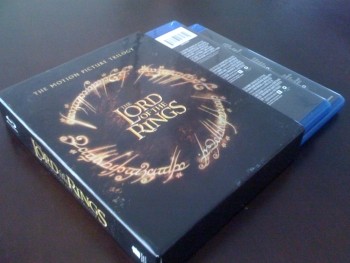 | 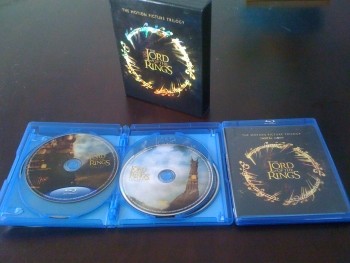 |
Warner / New Line Home Video have packaged The Lord of the Rings Trilogy in a sturdy, attractive boxset that contains two 1.5x-sized Blu-ray cases holding a total of nine discs -- three Blu-rays for the films, three standard-definition DVDs for the special features (which have 2010 date markings on them, though the content's the same as the first-run DVDs), and three Digital Copy discs. The outer box has a shiny, holographic look to the lettering within the ring, while also having embossed text on both the front and the spine for the Lord of the Rings title. As previously mentioned, these are the Theatrical Cuts of the films and do NOT contain the Extended Editions.
Each of the menu designs on the Blu-rays are supremely basic. Much like Warner Bros.' other recent Blu-ray releases, they do default to a menu screen instead of instantly starting with the film; however, the structure offers little more than a bland textured interface with a different musical track playing in the background for each. Subtitles are available in English SDH and Spanish.
Video and Audio:
The Fellowship of the Ring starts things off with a 2.35:1 1080p VC-1 codec, and it's ... well, underwhelming. Sure, it bests the standard-definition presentation's attributes by quite a bit, as well as offering the film in native 24fps movement; however, there are unquestionably a few issues with the way it's presented. Textures are extremely flat in many, if not most, of the sequences, appearing very smooth (possibly an aftereffect of noise reduction) and lacking dimension. The image, as a whole, also looks blurrier than expected, shown in close-ups on bearded folk and the hazy scenery. Several sequences lack these disappointing attributes -- an early close-up on the ring that's beautiful, a few of Frodo's close-quartered shots, and others. Contrast mostly looks ample and some instances of film grain are decently pleasing, but overall the image looks fairly artificial. It wasn't quite as apparent upon first glance, but the flaws become very evident after seeing the aptitude present in the second and third films' visual treatment. Still, it's not beyond watchable and has a few moments where it'll impress, but the impression it leaves as a whole isn't terribly favorable. A great scene to see all of its issues is the most important sequence in the picture: the roundtable consensus in Rivendel, where the Fellowship forms.
The other two films in the series, The Two Towers and The Return of the King, fair far better in their 1080p VC-1 visual treatments. Haziness and smooth textures aren't as readily visible in these two transfers (though slightly questionable in a few spots within The Two Towers), sporting crisp textures and wide-ranged, beautiful scenic shots across many points in the films. As Frodo, Sam, and Gollem force their way through the bogs and rocky terrains leading to Mount Doom, textural density becomes a primary visual draw -- and, for the most part, the detail's integrity is preserved and highly pleasing. Treebeard's bark, the minuscule etchings in Minas Tirith, and the visual effects, including that of the creature Gollem, are all preserved amid an image that rarely stops or slows down for a lengthy time. Furthermore, it also seems as if the palette richness in these other two discs also trumps that of The Fellowship of the Ring, rendering deeper greens, crisper colors in skylines, and a more satisfying level of near-grayscale contrast during the shots within the mountains. It's difficult to understand exactly why these two look much better than the first, but the quality here almost makes us forget the dissatisfying image that precedes them. They're still not perfect, a little hazier than expected for such a new film and still sporting smoothness in a few patches that's worrying, but much more appealing high-definition renderings.
The 6-channel DTS HD Master Audio tracks, on the other hand, are all pretty darn exquisite. You're not likely to get a more active array of tracks than these three powerhouses, rich with metal clashing, arrows zipping, throaty low-end smashes and everything in between. Each one impresses with their potently nerve-rattling quality, stretching wide with their sprawling sound intensity and doubly impressing with their delicateness in quieter sequences. Rear-channel activity occurs often and in active form, thoroughly enveloping us with its wide usage of ambient effects -- Gandalf's singing leading to The Shire, horns blowing, cranks churning at the Black Gate and lava spilling -- to create a universally immersive environment. Verbal clarity stays crisp at most points, though dwindling to slightly weak territories in a few spots. Moreover, there isn't a moment where Howard Shore's glorious score doesn't impress with its multifaceted, robust grandeur. Though the visual treatment's are a little on the questionable side, you're still getting a room-rattling, ear-swooning experience in these Lord of the Rings Blu-rays.
Special Features:
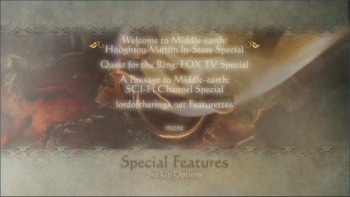 Each of the Blu-ray discs only have HD Trailers for the films themselves, a trailer for the Aragorn's Quest video game, and for the Lord of the Rings Trilogy itself. Nothing more, nothing less. Answering the question regarding the rest of the special features is pretty simple: each of these discs contains a "preview" for the standard-definition Extended Edition packages, each carrying their release dates -- November 2002 and 2003, and December 2004. What that means is that we've got the exact same second-disc DVD presentation from the theatrical DVD issues. DVDTalk has reviewed each of these, here for Fellowship, here for Two Towers, and here for Return of the King, but let's conduct a quick rundown of each slate of supplements per film:
Each of the Blu-ray discs only have HD Trailers for the films themselves, a trailer for the Aragorn's Quest video game, and for the Lord of the Rings Trilogy itself. Nothing more, nothing less. Answering the question regarding the rest of the special features is pretty simple: each of these discs contains a "preview" for the standard-definition Extended Edition packages, each carrying their release dates -- November 2002 and 2003, and December 2004. What that means is that we've got the exact same second-disc DVD presentation from the theatrical DVD issues. DVDTalk has reviewed each of these, here for Fellowship, here for Two Towers, and here for Return of the King, but let's conduct a quick rundown of each slate of supplements per film: The Fellowship of the Ring:
Houghton-Mifflin In-Store Special (16:44, 4x3) -- generic fluff assembly piece with a few splashes of unique insight.
Quest for the Ring: Fox TV Special (21:16, 4x3) -- a bit more in-depth, includes interviews and nice behind-the-scenes material.
Passage to Middle-earth: Sci-Fi Special (41:37, 4x3) -- similar to FoxTV piece, only more focused, deeper in context and interviews.
lordoftherings.net Featurettes -- fifteen (15) pieces ranging in material, each lasting between two to five (2-5) minutes.
Six TV Spots (3:06, 4x3), Enya's "May it Be" Video (3:38, 4x3), Fellowship EE Preview (3:05, 16x9), and "Two Towers" Preview (10:42).
The Two Towers:
On the Set: Starz/Encore Special (14:00, 4x3) -- lots of plot regurgitation, happily backslapping interviews, mildly insightful.
Return to Middle-earth: WB Special (42:54) -- deeper insight/vid doc into Two Towers, time spent in New Zealand, and construction of the film.
"The Long and Short of It": Sean Astin Short (7:04, 16x9) -- w/ Astin intro. Cute short film, featuring Jackson and other cast/crew.
Making of "The Long and Short of It" (8:07) -- assembly feature in Sean Astin's short.
lordoftherings.net Featurettes -- eight (8) pieces ranging in material, each lasting between two to five (2-5) minutes.
Sixteen (16) TV Spots (8:23, 4x3), "Gollem's Song" Music Video (4:03, 16x9), Two Towers EE Preview (5:15, 16x9), and "Return" Preview (12:33, 16x9).
The Return of the King:
The Quest Fulfilled: A Director's Journey (23:00, 4x3) -- quick, insightful history, speedbumps and all, of the three films' construction.
A Filmmaker's Journey (28:30, 4x3) -- fairly surface-level gloss over the creation of the films, nice behind-the-scenes shots & discussion.
National Geographic Special (45:56, 4x3) -- very in-depth, sober look at the films and their semi-influential history sources. Intriguing.
lordoftherings.net Featurettes -- six (6) pieces ranging in material, each lasting between two to five (2-5) minutes.
Fourteen (14) TV Spots (6:46, 4x3), and the Return of the King EE DVD Preview (6:56, 16x9)
Final Thoughts:
This is tough.
The Lord of the Rings Trilogy, a spectacle of sight and sound that still stands as Peter Jackson's crowning achievement, should be a benchmark of Blu-ray's capabilities; however, as offered here, it's little more than two-thirds (2/3) of a strong high-definition experience, and next to nothing in the realm of HD supplemental capabilities. The visual treatment for The Fellowship of the Ring slightly tarnishes what could be the best of the three films, while the inclusion of DVDs for the extras -- though still welcome -- comes off as sloppy since they're little more than the discs available with the previous theatrical standard-definition offerings. For the quality of the experience and the Blu-ray audiovisual renderings for The Two Towers and The Return of the King, this set earns a stiff Recommendation. More than likely, around the release of the Peter Jackson-produced, Guillermo Del Toro-directed The Hobbit, we'll see a beefy slate of special features and (hopefully) a remastered Fellowship of the Ring for a new, comprehensive boxset. Until then, this will have to do -- and it will, just not nearly to the degree that's come to be expected from New Line regarding this franchise.
|
| Popular Reviews |
| Sponsored Links |
|
|
| Sponsored Links |
|
|
| Release List | Reviews | Shop | Newsletter | Forum | DVD Giveaways | Blu-Ray | Advertise |
|
Copyright 2024 DVDTalk.com All Rights Reserved. Legal Info, Privacy Policy, Terms of Use,
Manage Preferences,
Your Privacy Choices | |||||||









